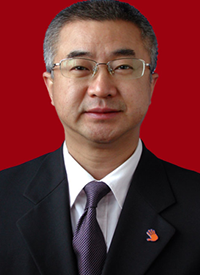News
Article
China’s NMPA Approves Selinexor for R/R DLBCL
Author(s):
Key Takeaways
- Selinexor approved in China for relapsed/refractory DLBCL based on phase 2 SEARCH study results.
- The study showed an ORR of 21.7%, with a complete response rate of 16.7%.
Selinexor has received approval as monotherapy for the treatment of patients with relapsed/refractory diffuse large B-cell lymphoma in China.
Jun Zhu, MD, PhD

China’s National Medical Products Administration (NMPA) has approved single-agent selinexor (Xpovio) for the treatment of adult patients with relapsed/refractory diffuse large B-cell lymphoma (DLBCL).1
The regulatory decision was supported by data from the phase 2 SEARCH study (NCT03992339) in China, which showed that central radiological review–assessed responses were observed among 60 Chinese patients treated with the oral XPO1 inhibitor, meeting the study's prespecified primary end point of overall response rate (ORR).
"DLBCL is the most common subtype of non-Hodgkin lymphoma [NHL] in adults and accounts for 40% of all NHL cases in China. The incidence of NHL has been steadily rising year over year, while patients with third- and later-lines relapsed or refractory disease lack effective and convenient therapies,” SEARCH principal investigator Jun Zhu, MD, PhD, of Peking University affiliated Beijing Cancer Hospital, stated in a news release. “As a XPO1 inhibitor with a novel mechanism of action, selinexor offers patients a new treatment option that is efficacious and easy to use, with oral availability that can reduce hospitalization and financial burden on patients by allowing them to receive treatment at home. Overall, the approval for this new indication of selinexor is indeed great news for Chinese patients with relapsed/refractory DLBCL."
SEARCH was a single-arm, open-label, registrational bridging study evaluating the efficacy and safety of selinexor in patients 18 years of age or older who had either pathologically confirmed de novo DLBCL or DLBCL transformed from previously diagnosed indolent lymphoma that was treated with at least 2, but no more than 5, prior systemic regimens. An ECOG performance status of 2 or less; an estimated life expectancy of at least 3 months at study entry; and ineligibility for high-dose chemotherapy with autologous stem cell transplantation rescue were required.2
Upon enrollment, patients were treated with a fixed 60-mg dose of oral selinexor administered twice weekly every 4 weeks. Treatment continued until either disease progression or unacceptable toxicity.
The study’s primary end point was ORR, and key secondary end points included duration of response (DOR), disease control rate, progression-free survival (PFS), and overall survival (OS).
Results from SEARCH presented at the 2024 EHA Congress demonstrated an ORR of 21.7% (95% CI, 12.1%-34.2%), including a complete response rate of 16.7%. The median DOR was 7.6 months, the median PFS was 1.9 months, and the median OS was 8.5 months. All patients experienced at least 1 treatment-emergent adverse effect; however, these were generally manageable with appropriate supportive care and dose modification.3
The NMPA previously approved selinexor in 2021 for use in combination with dexamethasone in patients with relapsed/refractory multiple myeloma who previously received treatment and whose disease is refractory to at least a proteasome inhibitor, an immunomodulatory agent, and an anti-CD38 monoclonal antibody.4
The agent received accelerated approval from the FDA in June 2020 for the treatment of adult patients with relapsed/refractory DLBCL not otherwise specified after 2 or more lines of systemic therapy. In December 2020, the FDA also approved the agent in combination with the proteasome inhibitor bortezomib (Velcade) and dexamethasone for patients with multiple myeloma who have received at least 1 prior therapy. The first-in-class agent was initially approved in 2019 for use alongside dexamethasone in refractory disease after prior exposure to at least 4 therapies.5
References
- Xpovio (selinexor) approved for new indication in DLBCL in China, bringing a new treatment option to patients in the country. News release. Antengene. July 5, 2024. Accessed July 8, 2024. https://www.antengene.com/newsinfo/391
- A study of evaluating the safety and efficacy of ATG-010 in relapsed/refractory diffuse large B-cell lymphoma (SEARCH). ClinicalTrials.gov. Updated March 29, 2023. Accessed July 8, 2024. https://clinicaltrials.gov/study/NCT03992339
- Yugin S, Cai Q, Zhang Q, et al. Phase 2 SEARCH study: selinexor (ATG-010) monotherapy in heavily pretreated Chinese patients with relapsed or refractory diffuse large B-cell lymphoma. Presented at: 2024 EHA Congress; June 13-16, 2024; Madrid, Spain. Abstract PB3014.
- Karyopharm’s partner Antengene receives approval in China for Xpovio (selinexor) for the treatment of patients with relapsed or refractory multiple myeloma. News release. Karyopharm Therapeutics,; December 17, 2021. Accessed July 8, 2024. https://investors.karyopharm.com/2021-12-17-Karyopharms-Partner-Antengene-Receives-Approval-in-China-for-XPOVIO-R-selinexor-for-the-Treatment-of-Patients-with-Relapsed-or-Refractory-Multiple-Myeloma
- Xpovio. Prescribing information. Karyopharm Therapeutics; 2020. Accessed July 8, 2024.https://www.karyopharm.com/wp-content/uploads/2019/07/NDA-212306-SN-0071-Prescribing-Information-01July2019.pdf









